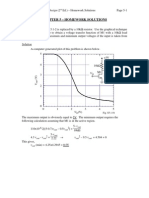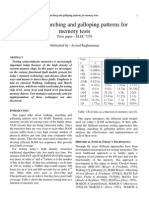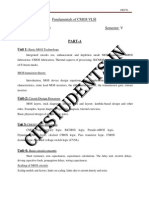Image Processing To Manipulate RGB Values Using Verilog.
Uploaded by
Ashutosh LembheImage Processing To Manipulate RGB Values Using Verilog.
Uploaded by
Ashutosh LembheImage Processing to manipulate RGB values using
Verilog.
2nd Sanjana Vernekar 3rd Dr. Sumathi V
UG student, School of Electrical Associate Professor, School of
1st Ashutosh Lembhe
Engineering Electrical Engineering
UG student, School of Electrical Vellore Institute of Technology, Vellore Institute of Technology,
Engineering Chennai Chennai
Vellore Institute of Technology, Chennai, India Chennai, India
Chennai.
Chennai, India
ashutoshlembhe50@gmail.com
Abstract—Image processing is a widely used application in a hardware structure, timing information about a
today’s world. Be it a photo taken from phone or camera. hypothetical hardware implementation is also available,
There is a process that goes into it to make the image allowing for specialised speed enhancements.
stabilized. Python is mostly used for image processing because
of its easy coding and libraries used for different operations.
We have implemented the image processing in the Verilog code.
In this paper we have showed how we converted an image in a
hex file using MATLAB and then used the hex file in Verilog
coding to perform some image processing operations. We have
Xilinx to write our code and perform the operations. There will
be an output image after the code is compiled and run. We will
be performing basic three operation for an image that will be
in a hex file as an input. The Three basic operations are
inverting of the image, threshold operation of the image, image Fig 1: Image Processing Block Diagram.
brightness reduction. This paper also aims to show how to
process an image using Verilog from reading an input bitmap II. MATLAB CODING FOR HEX FILE.
image in Verilog, processing and writing the processed result to
Images cannot be read directly by Verilog. The
an output bitmap image in Verilog.
image must be transformed from bitmap to hexadecimal
Keywords—Image Processing, Verilog HDL, FPGA, RGB format before it can be read in Verilog. To convert a
Values. bitmap image to a.hex file, we use MATLAB the input
image needs to be converted into 768x512 pixels, and
I. INTRODUCTION the image.hex file contains the bitmap image's R, G, and
Image processing is a technique for applying operations on B data. Below is the photo of code used for converting
an image in order to improve it or extract relevant bitmap image into a hex file.
information from it. It's a sort of signal processing in which
the input is an image and the output is either that image or
its characteristics/features. Image processing basically
includes the following three steps:
● Importing Image hex file via image acquisition
tool.
● Analysing and manipulating the image.
● Output in which image can be a altered image or
report that is based on image analysis.
By using Verilog hardware descriptive language we can
directly code at hardware level and enjoy its hardware
portability advantage. Verilog allows us to read hex file for
manipulation of image easily. By using Verilog hardware Fig 2: MATLAB hex file code.
engineer can easily analyse the circuit synthesis by using
one of the Xilinx’s property to create circuit with use of The image is named as input for MATLAB code to
identify it in the same folder. The image is send through
Verilog code. Because Verilog syntax is constantly linked to
some iterations in for loop. Notice the loop is from 512 to
XXX-X-XXXX-XXXX-X/XX/$XX.00 ©20XX IEEE
786 same as the pixels of the image. In the iterations the color has been created. One for storing even data and
images RGB data is extracted and a file name input.hex is another for storing odd data. In the "parameter.v" file, the
given out by using the commad fopen. The input hex file image processing operation is chosen. Simply switch the
only contains RGB vectors for each pixel of the input comment line to change the processing operation.
image. The next section covers the Verilog part of the
research. A. Brightness Operation Verilog Code.
This module changes the brightness of the image by
III. VERILOG CODING FOR IMAGE READ OPERATIONS adding or removing a fixed value from the pixel value. The
Image processing operations are now implemented in following code adds and subtracts a constant value from the
Verilog. The Verilog coding is divided into two parts, first is pixel values of a picture. In this, two types of operations are
implementation where parameters for operations such as coded. One is brightness addition and other is brightness
brightness, invert, threshold are declared. The second is subtraction.
simulation part where the above operations are defined and
coded in details. Xilinx allows the use to simulate on virtual
board in its environment. The board chosen for virtual
simulation is VIRTEX 6 FPGA board.
We will be performing three types of operations on the
image. Brightness operation, Inverting operation and
Threshold operation. Below is the image of operation
definition file.
Fig 3: Parameters file from where operations will be Fig 5: Brightness addition Verilog Code.
defined.
When sign variable is declared one in image read module
To read the image hexadecimal data file, Verilog uses the operation performed on the image is brightness addition.
the command $readmemh. After reading the image.hex file, The temp variables perform an calculations using the above
the RGB picture data is kept in memory and read out for formulas and check of the value exceeds the limit of 255, if
processing. Below is the image of image read module. yes then it assigns the RGB data the value of 255.
Fig 4: Image read Module.
The image width and height are stored in their respective
variables. An array is also created for storing RGB data after
going through series of operations. Two arrays for each Fig 6: Brightness subtraction Verilog Code.
If the variable sign is assigned 0 then the operational code no then all even and odd data RGB values are set to 0.
will be as shown in fig 6. If the value calculated from the These two values are the uppermost and lowermost
formula comes to be less than 0 then the variables for for threshold value.
RGB data are assigned to 0. The formula involves using the
width, row and col values. IV. VERILOG CODING FOR IMAGE WRITE OPERATIONS
The "parameter.v" file which was mentioned earlier also
specifies the input and output file directories and names.
B. Invert Operation Verilog Code. After processing the image, the processed data must be
This module inverts an image by inverting the bits of the written to an output image for verification purposes.
grayscale pixel value. The RGB pixel values must be
equalised to convert a coloured image to a grayscale image,
which is done by averaging the three colour components.
Fig 9: Image write module in Verilog.
Fig 7: Invert Operation Verilog Code.
From the fig it is clearly shown that the value2 and The output file image is stored in the variable infile. An
value4 variables are used to store the average values after array is also been created for temporary image storage.
calculating the average value using RGB. Value2 is used for
calculation of even data RGB values by subtracting it from
255 and storing it in the respective variables.
Value4 variable is used for calculating odd data of RGB
values. Note that the formula for calculating value4 and
value2 is slightly different.
C. Threshold Operation Verilog Code.
This Verilog code is used to perform the threshold
operation, which consists of setting the pixel value over a
threshold value to 255 and the pixel value below the
threshold value to 0. To perform the threshold operation, we
can use the Verilog testing code shown below.
Fig 10: Header data for BMP image.
The above is the code for a 54 byte header in Verilog. The
bitmap image's header info is extremely significant. The
written picture may not be shown appropriately if there is no
header data.
Fig 8: Threshold operation Verilog code.
As shown in the code above both lower and upper limit
is set. The if condition checks if the value calculated
through the formula given is above threshold or not, if
yes then all odd and even data values are set to 255. If
Run the simulation, close the simulation and open the output
image for checking the result. Followings are the output
images which are processed by the selected operations in
parameter.v.
Fig 11: Verilog Code for storing of temporary memory of
image.
The above iterative loop is used for counting rows and
column index for temporary memory to save image data.
Fig 14: Reduced Brightness Image output.
We can see that the brightness has been reduced
significantly. The code shown in fig 6 has done its role and
subtracted the brightness from its original image and
lowered it.
Fig 12: Verilog code for writing the BMP image.
$fwrite is a Verilog command used to write data to file.
V. RESULTS.
Here are the simulation results produced by applying the
operations outlined in Verilog HDL to an input image. The Fig 15: Inverted Image output.
image given as an input is of the size 768x512. This image
will first be given as an input to MATLAB. Then its hex file For inverting operation the value must have been subtracted
is generated which will be given as an input to the Verilog from 255 to reach this contrast level for the output image.
coding in Xilinx.
Fig 16: Threshold Image output.
Fig 13: Original Input Bitmap image.
Black and white is obtained after threshold operations. The [1] John C. Russ - “Image Processing Handbook
threshold value obtained here was around 120 after the code (sixthedition)”, CRC Press, pp. 270-331, 2011
was executed.
[2] Raman Maini, H. Aggarwal - “A Comprehensive
VI. CONCULSION Review of Image enhancement Techniques”, Journal of
Computing, vol. 2, issue 3, ISSN 2151-9617, pp.
The results obtained were promising. Verilog has the ability 269-300, 2010
to manipulate RGB values without the need of any external
library. With help of iterative loops and mathematical
formulas the image processing operations were [3] Wilhelm Burger, Mark J. Burge -“Principles of Digital
implemented successfully. It can be concluded that Verilog Image Processing – Fundamental Techniques”,
can also be used for image processing operations and can be Undergraduate Topics in Computer Science
directly used for coding at hardware level.
[1] 10.1007/978-1-84800-191-6_4, Springer- Verlag
VII. REFERENCES London Limited, 2009.
[4] A. Zuloaga, J.L. Martin, U. Bidarte, J.A. Ezquerra -
“VHDL test bench for digital image processing systems
using a new image format”, ECSI, 2007
(http://mx.reocities.com/CapeCanaveral/8482/).
[5] Daggu Venkateshwar Rao, Shruti Patil, Naveen Anne
Babu and V. Muthukumar - “Implementation and
Evaluation of Image Processing Algorithms on
Reconfigurable Architecture using C-based Hardware
Descriptive Languages”, International Journal of
Theoretical and Applied Computer Sciences, Volume 1,
Number 1, pp. 9–34, 2006
[6] “Verilog HDL” by Samir Palnitkar, 2003, ISBN 0-13-
044911-3 [Publisher: Prentice Hall PTR]
[7] R. C. Gonzalez, R. E. Woods – “Digital Image
Processing”, Prentice Hall, ISBN 0-13-094659-8, pp. 1-
142, 2002.
[8] Bovik, A. (Ed.). (2000). Handbook of image and video
processing. Texas: Academic Press.
[9] Nick Efford - “Digital Image Processing – A Practical
Introduction Using Java”, pp. 103-132, 2000.
[10] Fisher, R., Perkins, S., Walker, A., & Wolfart, E.
(1996). Hypermedia image processing reference.
Chichester: John Wiley & Sons, Inc
You might also like
- ALV Grid Display With Checkbox To Process Selected Records at RuntimeNo ratings yetALV Grid Display With Checkbox To Process Selected Records at Runtime20 pages
- Lab Manual With Procedure For Xilinx and MicrowindNo ratings yetLab Manual With Procedure For Xilinx and Microwind102 pages
- Implementing 7 4 Hamming Code Encoding and Decoding System Using CPLD IJERTV2IS70300No ratings yetImplementing 7 4 Hamming Code Encoding and Decoding System Using CPLD IJERTV2IS703006 pages
- Arm Neoverse N2:: Arm'S 2 Generation High Performance Infrastructure Cpus and System Ips100% (1)Arm Neoverse N2:: Arm'S 2 Generation High Performance Infrastructure Cpus and System Ips27 pages
- Systemverilog Procedural Statements: New OperatorsNo ratings yetSystemverilog Procedural Statements: New Operators15 pages
- Design and Simulation of ZIGBEE TransmitterNo ratings yetDesign and Simulation of ZIGBEE Transmitter5 pages
- Design and Implementation of 64 Bit Alu Using VHDLNo ratings yetDesign and Implementation of 64 Bit Alu Using VHDL59 pages
- Hybrid Low Radix Encoding-Based Approximate Booth Multipliers100% (1)Hybrid Low Radix Encoding-Based Approximate Booth Multipliers33 pages
- Voltage Controlled Oscillator - Usage of VCO, Working and ApplicationNo ratings yetVoltage Controlled Oscillator - Usage of VCO, Working and Application9 pages
- Radix-4 Modified Booth's Multiplier Using Verilog RTLNo ratings yetRadix-4 Modified Booth's Multiplier Using Verilog RTL10 pages
- Verilog Labs: Introduction To Lab ExercisesNo ratings yetVerilog Labs: Introduction To Lab Exercises9 pages
- Assertion Amp Functional Coverage Driven Verification of AMBA Advance Peripheral Bus Protocol Using System Verilog100% (1)Assertion Amp Functional Coverage Driven Verification of AMBA Advance Peripheral Bus Protocol Using System Verilog6 pages
- Fully-Differential High-Speed and High-Precision Operational Amplifier DesignsNo ratings yetFully-Differential High-Speed and High-Precision Operational Amplifier Designs9 pages
- Design and Implementation of IOT Based VNo ratings yetDesign and Implementation of IOT Based V6 pages
- VHDL Program: Experiment: 1 Aim: To Write A VHDL Program For: I) 8 Bit ComparatorNo ratings yetVHDL Program: Experiment: 1 Aim: To Write A VHDL Program For: I) 8 Bit Comparator6 pages
- Top 21 Computer Architecture Interview Questions & AnswersNo ratings yetTop 21 Computer Architecture Interview Questions & Answers5 pages
- Fpga Based Coin Recognition System: A Technical ReportNo ratings yetFpga Based Coin Recognition System: A Technical Report14 pages
- A Practical Guide To Adopting The Universal Verification Methodology (Uvm) Second EditionNo ratings yetA Practical Guide To Adopting The Universal Verification Methodology (Uvm) Second Edition2 pages
- Elevator Control Using Speech Recognition For People With Physical DisabilitiesNo ratings yetElevator Control Using Speech Recognition For People With Physical Disabilities4 pages
- Design and Implementation of VGA Controller On FPGANo ratings yetDesign and Implementation of VGA Controller On FPGA8 pages
- Design and Implementation of Ripple Carry Adder Using Area Efficient Full Adder Cell in 180nm CMOS TechnologyNo ratings yetDesign and Implementation of Ripple Carry Adder Using Area Efficient Full Adder Cell in 180nm CMOS Technology6 pages
- B.Tech Project Mid Term Report: Handwritten Digits Recognition Using Neural NetworksNo ratings yetB.Tech Project Mid Term Report: Handwritten Digits Recognition Using Neural Networks13 pages
- Application-Specific Integrated Circuit ASIC A Complete GuideFrom EverandApplication-Specific Integrated Circuit ASIC A Complete GuideNo ratings yet
- Image Edge Detection in FPGA: Tejas Khairnar, Harikiran, Avinash Chandgude, Sivanantham S, Sivasankaran KNo ratings yetImage Edge Detection in FPGA: Tejas Khairnar, Harikiran, Avinash Chandgude, Sivanantham S, Sivasankaran K4 pages
- FPGA Implementation of Image Enhancement Using Verilog HDLNo ratings yetFPGA Implementation of Image Enhancement Using Verilog HDL4 pages
- Hardware Software Co-Simulation For Image Processing ApplicationsNo ratings yetHardware Software Co-Simulation For Image Processing Applications3 pages
- Implementation of FPGA Based Image Processing Algorithm Using PDFNo ratings yetImplementation of FPGA Based Image Processing Algorithm Using PDF6 pages
- Paper 5-An RGB Image Encryption Supported by Wavelet-Based Lossless CompressionNo ratings yetPaper 5-An RGB Image Encryption Supported by Wavelet-Based Lossless Compression6 pages
- OpenText Exstream Design and Production CE 24.1.0 Release NotesNo ratings yetOpenText Exstream Design and Production CE 24.1.0 Release Notes17 pages
- KT 400 Installation Guide v01 11 MN LT enNo ratings yetKT 400 Installation Guide v01 11 MN LT en56 pages
- Blackline Sap Core: External Api ConfigurationNo ratings yetBlackline Sap Core: External Api Configuration25 pages
- jBASE SQL Language: © 2006, 2016 Zumasys, IncNo ratings yetjBASE SQL Language: © 2006, 2016 Zumasys, Inc27 pages
- 200+ TOP DBMS Online Quiz Questions - Exam Test: Search Here For SkillNo ratings yet200+ TOP DBMS Online Quiz Questions - Exam Test: Search Here For Skill15 pages
- Bridge Oracle System: Last Update: September 7 2020 White Paper Version: V 0.1.2No ratings yetBridge Oracle System: Last Update: September 7 2020 White Paper Version: V 0.1.224 pages
- Software Project Planning (Feasibility)No ratings yetSoftware Project Planning (Feasibility)18 pages
- Autodesk Revit2011-2012 Victaulic ReadMeNo ratings yetAutodesk Revit2011-2012 Victaulic ReadMe3 pages
- MatrikonOPC Server For Simulation Quick Start Guide PDFNo ratings yetMatrikonOPC Server For Simulation Quick Start Guide PDF2 pages
- ALV Grid Display With Checkbox To Process Selected Records at RuntimeALV Grid Display With Checkbox To Process Selected Records at Runtime
- Lab Manual With Procedure For Xilinx and MicrowindLab Manual With Procedure For Xilinx and Microwind
- Implementing 7 4 Hamming Code Encoding and Decoding System Using CPLD IJERTV2IS70300Implementing 7 4 Hamming Code Encoding and Decoding System Using CPLD IJERTV2IS70300
- Arm Neoverse N2:: Arm'S 2 Generation High Performance Infrastructure Cpus and System IpsArm Neoverse N2:: Arm'S 2 Generation High Performance Infrastructure Cpus and System Ips
- Systemverilog Procedural Statements: New OperatorsSystemverilog Procedural Statements: New Operators
- Design and Implementation of 64 Bit Alu Using VHDLDesign and Implementation of 64 Bit Alu Using VHDL
- Hybrid Low Radix Encoding-Based Approximate Booth MultipliersHybrid Low Radix Encoding-Based Approximate Booth Multipliers
- Voltage Controlled Oscillator - Usage of VCO, Working and ApplicationVoltage Controlled Oscillator - Usage of VCO, Working and Application
- Radix-4 Modified Booth's Multiplier Using Verilog RTLRadix-4 Modified Booth's Multiplier Using Verilog RTL
- Assertion Amp Functional Coverage Driven Verification of AMBA Advance Peripheral Bus Protocol Using System VerilogAssertion Amp Functional Coverage Driven Verification of AMBA Advance Peripheral Bus Protocol Using System Verilog
- Fully-Differential High-Speed and High-Precision Operational Amplifier DesignsFully-Differential High-Speed and High-Precision Operational Amplifier Designs
- VHDL Program: Experiment: 1 Aim: To Write A VHDL Program For: I) 8 Bit ComparatorVHDL Program: Experiment: 1 Aim: To Write A VHDL Program For: I) 8 Bit Comparator
- Top 21 Computer Architecture Interview Questions & AnswersTop 21 Computer Architecture Interview Questions & Answers
- Fpga Based Coin Recognition System: A Technical ReportFpga Based Coin Recognition System: A Technical Report
- A Practical Guide To Adopting The Universal Verification Methodology (Uvm) Second EditionA Practical Guide To Adopting The Universal Verification Methodology (Uvm) Second Edition
- Elevator Control Using Speech Recognition For People With Physical DisabilitiesElevator Control Using Speech Recognition For People With Physical Disabilities
- Design and Implementation of VGA Controller On FPGADesign and Implementation of VGA Controller On FPGA
- Design and Implementation of Ripple Carry Adder Using Area Efficient Full Adder Cell in 180nm CMOS TechnologyDesign and Implementation of Ripple Carry Adder Using Area Efficient Full Adder Cell in 180nm CMOS Technology
- B.Tech Project Mid Term Report: Handwritten Digits Recognition Using Neural NetworksB.Tech Project Mid Term Report: Handwritten Digits Recognition Using Neural Networks
- Application-Specific Integrated Circuit ASIC A Complete GuideFrom EverandApplication-Specific Integrated Circuit ASIC A Complete Guide
- Image Edge Detection in FPGA: Tejas Khairnar, Harikiran, Avinash Chandgude, Sivanantham S, Sivasankaran KImage Edge Detection in FPGA: Tejas Khairnar, Harikiran, Avinash Chandgude, Sivanantham S, Sivasankaran K
- FPGA Implementation of Image Enhancement Using Verilog HDLFPGA Implementation of Image Enhancement Using Verilog HDL
- Hardware Software Co-Simulation For Image Processing ApplicationsHardware Software Co-Simulation For Image Processing Applications
- Implementation of FPGA Based Image Processing Algorithm Using PDFImplementation of FPGA Based Image Processing Algorithm Using PDF
- Paper 5-An RGB Image Encryption Supported by Wavelet-Based Lossless CompressionPaper 5-An RGB Image Encryption Supported by Wavelet-Based Lossless Compression
- OpenText Exstream Design and Production CE 24.1.0 Release NotesOpenText Exstream Design and Production CE 24.1.0 Release Notes
- 200+ TOP DBMS Online Quiz Questions - Exam Test: Search Here For Skill200+ TOP DBMS Online Quiz Questions - Exam Test: Search Here For Skill
- Bridge Oracle System: Last Update: September 7 2020 White Paper Version: V 0.1.2Bridge Oracle System: Last Update: September 7 2020 White Paper Version: V 0.1.2
- MatrikonOPC Server For Simulation Quick Start Guide PDFMatrikonOPC Server For Simulation Quick Start Guide PDF

























































































